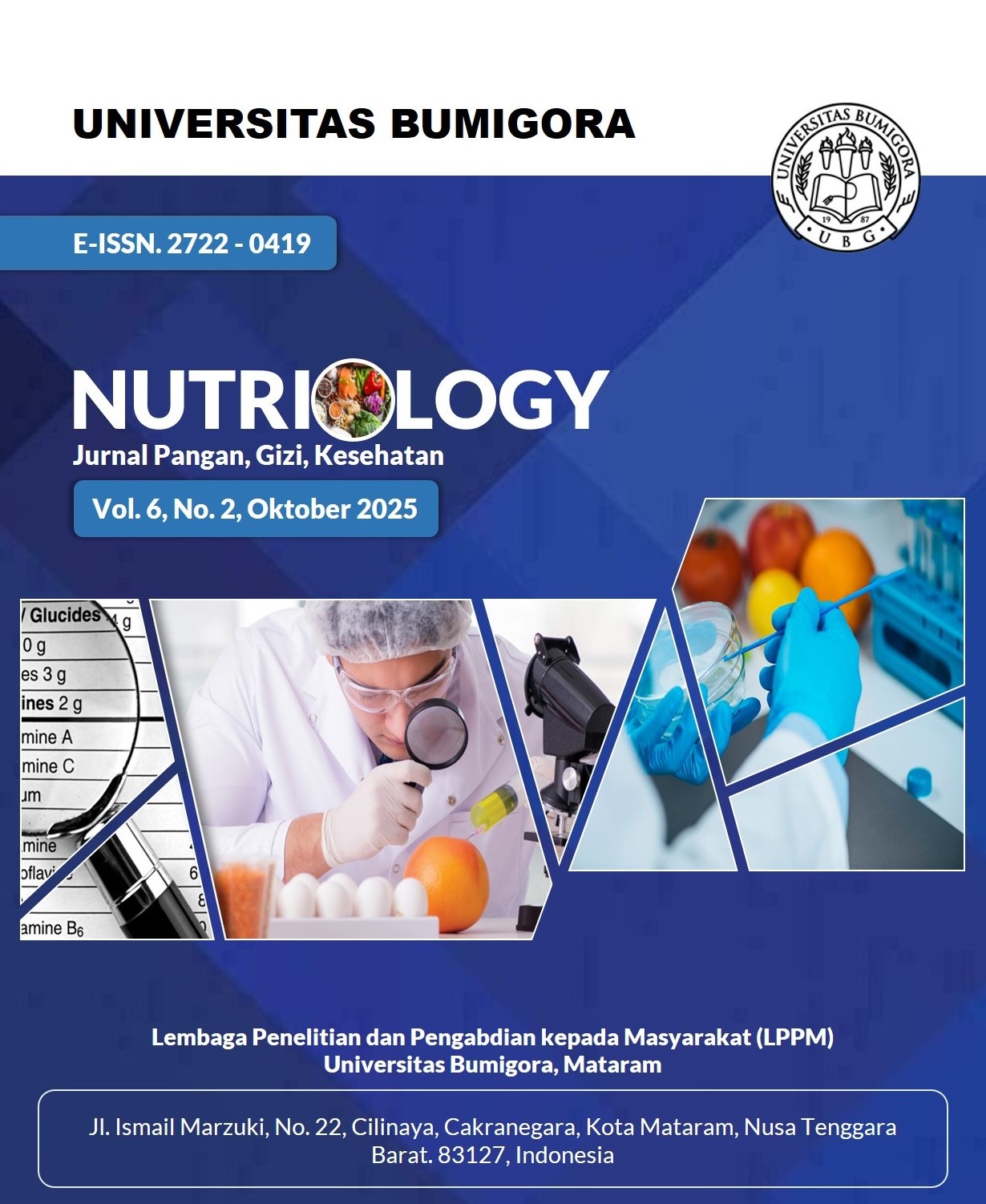Analisis Antosianin dan Aktivitas Antioksidan Kue Apem Komposit Ubi Jalar Ungu dan Jagung dengan Metode pH Differensial dan DPPH
DOI:
https://doi.org/10.30812/nutriology.v6i2.5293Kata Kunci:
aktivitas antioksidan, kadar antosianin, kue apeng, tepung ubi jalar ungu, tepung jagungAbstrak
Oxidative stress indicates an imbalance between free radicals and antioxidants, which can potentially cause health problems. This condition can be prevented through the intake of foods rich in antioxidants, including modifying local foods that use purple sweet potato flour and corn flour in Apem cakes as a composite ingredient for rice flour. The purpose of this study was to determine the effect of purple sweet potato flour and corn flour composites on anthocyanin levels and antioxidant activity in Apem cakes. The research method uses an experiment with a completely randomized design consisting of four types treatment based on the percentage of flour comparison. A: 100% rice flour; B: 15% purple sweet potato flour + 35% corn flour + 50% rice flour; C: 25% purple sweet potato flour + 25% corn flour + 50% rice flour; D: 35% purple sweet potato flour + 15% corn flour + 50% rice flour. Anthocyanin content was tested using the pH differential method, and antioxidant activity was analyzed using the DPPH method. The results of this study showed that there were significant differences in anthocyanin content and antioxidant activity between treatments, with p-values of 0.003 and 0.000, respectively. The conclusion was that the highest anthocyanin content and antioxidant activity were found in Apem Cake treatment D, which was 20.14 ppm and 70.74%.
Referensi
[1] R. U. Ayudiah, T. S. Dinda, and T. Felly, “Artikel Review : Stres Oksidatif dan Penyakitnya,” Research Gate, 2023, [Online]. Available: https://www.researchgate.net/publication/366903090.
[2] T. Senoner and W. Dichtl, “Oxidative Stress in Cardiovascular Diseases: Still a Therapeutic Target?,” Nutrients, vol. 11, no. 9, Sep. 2019, https://doi.org/10.3390/nu11092090.
[3] World Health Organization (WHO), “Noncommunicable Diseases.” Accessed: Jul. 16, 2025. [Online]. Available: https://www.who.int/news-room/fact-sheets/detail/noncommunicable-diseases.
[4] Kementrian Kesehatan RI, Laporan Nasional Riskesdas 2018. Jakarta: Badan Penelitian dan Pengembangan Kesehatan , 2018.
[5] R. A. Ifadah, P. R. W. Wiratara, and C. A. Afgani, “Ulasan Ilmiah : Antosianin dan Manfaatnya untuk Kesehatan,” Jurnal Teknologi Pengolahan Pertanian, vol. 3, no. 2, p. 11, Jan. 2021, https://doi.org/10.35308/jtpp.v3i2.4450.
[6] M. Priska, N. Peni, L. Carvallo, and Y. D. Ngapa, “Review: Antosianin dan Pemanfaatannya,” Cakra Kimia (Indonesian E-Journal of Applied Chemistry, vol. 6, no. 2, 2018.
[7] Badan Pusat Statistik Indonesia, Statistik Indonesia (Statistical Yearbook of Indonesia) 2024. 2024.
[8] B. N. Arifin, N. Suhartatik, and A. Mustofa, “Antioxidant Activity of Colored Rice Flour with Drying Temperature Variations,” Jurnal Teknologi dan Industri Pangan UNISRI, vol. 8, no. 2, pp. 195–202, 2023, https://doi.org/10.33061/jitipari.v8i2.7250.
[9] Kementerian Kesehatan RI, Tabel Komposisi Pangan Indonesia. Jakarta: Kementerian Kesehatan RI, 2017.
[10] I. N. S. Taleo, Ansharullah, and M. S. Sadimantara, “Karakteristik Sifat Fisikokimia dan Aktivitas Antioksidan pada Beras Merah (Oryza nivara) Termodifikasi HMT (Heat Moisture Treatment) Asal Tana Toraja,” Jurnal Riset Pangan, vol. 2, no. 4, pp. 377–390, 2024.
[11] S. Farida, E. A. Saati, Damat, and A. Wahyudi, Potensi Ubi Jalar Ungi Analisis Kandungan Antosianin. Malang: PT. Literasi Nusantara Abadi Grup, 2024.
[12] N. P. A. D. Putri, I. D. G. M. Permana, and L. P. T. Darmayanti, “Pengaruh Perbandingan Tepung Ubi Jalar Ungu (Ipomoea batatas L.) dan Tepung Beras (Oryza sativa L.) terhadap Karakteristik Kue Putu Mayang,” Itepa: Jurnal Ilmu dan Teknologi Pangan, vol. 13, no. 2, pp. 316–334, 2024.
[13] Sachriani and Mariani, “Karakteristik Kimia dan Kualitas Organoleptik Produk Madeleine Cake Substitusi Tepung Jagung Sebagai Diversifikasi Bahan Pangan Lokal,” Jurnal Sains Terapan, pp. 55–61, 2019, https://doi.org/10.32487/jst.v10i2.2252.
[14] D. Saputro and P. Kurnia, “Pengaruh Penggunaan Tepung Biji Kecipir (Psophocarpas tetragonolobusL.) Sebagai Substitusi Tepung Beras dalam Pembuatan Kue Apem Terhadap Kadar Protein dan Daya Terima,” Universitas Muhammadiyah Surakarta, 2016.
[15] L. N. Khasanah, P. Kurnia, and E. Purwani, “Pengaruh Substitusi Tepung Ubi Jalar Oranya pada Pembuatan Apem Ditinjau dari Kadar B-Karoten dan Daya Terima,” Universitas Muhammadiyah Surakarta, 2016.
[16] A. T. Wati and E. M. Intani, “Penambahan Tepung Ubi Ungu (Ipomea batatas L.) Terhadap Sifat Organoleptik dan Kimia dalam Pembuatan Pizza,” Jurnal Teknik Pertanian Lampung, vol. 10, no. 4, pp. 488–495, Dec. 2021, https://doi.org/10.23960/jtep-l.v10i4.488-495.
[17] W. Insani, N. M. Yusa, and S. Hatiningsih, “Pengaruh Perbandingan Tepung Okara dan Tepung Beras Terhadap Karakteristik Kue Apem,” Itepa: Jurnal Ilmu dan Teknologi Pangan, vol. 12, no. 1, 2023, doi: https://doi.org/10.24843/itepa.2023.v12.i01.p01.
[18] S. A. P. Wijaksono, R. Hasanah, and K. N. Wahyusi, “Ekstraksi Maserasi Antosianin pada Beberapa Jenis Ubi Jalar Ungu dengan Metode pH Diferensial Spektrofotometri,” 2024.
[19] Surianti, Rukmelia, and A. Nurwidah, “Pengaruh Penambahan Tepung Ubi Jalar Ungu (Ipomoea batatas L.) pada Pembuatan Roti Bagel,” Gorontalo Agriculture Technology Journal, vol. 8, no. 1, p. 2025, 2025, doi: https://doi.org/10.32662/gatj.v0i0.3867.
[20] A. F. Khotimah, D. Handito, and N. Rahayu, “Pengaruh Fortifikasi Tepung Ubi Jalar Ungu Terhadap Aktivitas Antioksidan dan Sifat Organoleptik Kue Simping Khas Purwakarta,” EduFood, vol. 2, no. 3, pp. 71–84, 2024.
[21] S. Holuke, Ansharullah, and RH. F. Faradilla, “Pengaruh Substitusi Tepung Ubi Jalar Ungu (Lpomea batatas poiret) Terhadap Kadar Antioksidan, Kadar Serat, dan Kualitas Organoleptik Kue Donat,” Jurnal Sains dan Teknologi Pangan, vol. 4, no. 1, pp. 1992–2002, 2019, http://dx.doi.org/10.33772/jstp.v4i1.5636.
[22] M. T. Septian, F. D. Wahyuni, and A. Nora, “Uji Aktivitas Antioksidan dengan Metode DPPH dan Identifikasi Golongan Metabolit Sekunder pada Daging Ubi Jalar dari Berbagai Daerah di Indonesia,” SPIN Jurnal Kimia & Pendidikan Kimia, vol. 4, no. 2, pp. 185–196, 2022, https://doi.org/10.20414/spin.v4i2.5734.
[23] F. N. Kurniasari, Y. Rahmi, C. I. P. Devina, N. R. Aisy, and A. R. Cempaka, “Perbedaan Kadar Antosianin Ubi Ungu Segar dan Tepung Ubi Ungu Varietas Lokal dan Antin 3 pada Beberapa Alat Pengeringan,” Journal of Nutrition College, vol. 10, no. 4, pp. 313–320, 2021, [Online]. Available: http://ejournal3.undip.ac.id/index.php/jnc/.
[24] H. A. Prasetyo and R. R. Winardi, “Perubahan Komposisi Kimia dan Aktivitas Antioksidan pada Pembuatan Tepung dan Cake Ubi Jalar Ungu (Ipomoea batatas L.),” Jurnal Agrica Ekstensia, vol. 14, no. 1, pp. 25–32, 2020, https://doi.org/10.55127/ae.v14i1.33.
[25] M. F. Alfaridzi, “Kajian Literatur: Uji Aktivitas Antioksidan Antosianin In Vitro,” Universitas Muhammadiyah Surakarta, 2020.
[26] H. Suhendy, L. N. Wulan, and H. Nur Laili Dwi, “Pengaruh Bobot Jenis Terhadap Kandungan Total Flavonoid dan Fenol Ekstrak Etil Asetat Umbi Ubi Jalar Ungu-Ungu (Ipomoea batatas L.),” Journal of Pharmacopolium, vol. 5, no. 1, pp. 18–24, 2022, https://doi.org/10.55127/ae.v14i1.33.
[27] Y. R. Im, I. Kim, and J. Lee, “Phenolic Composition and Antioxidant Activity of Purple Sweet Potato (Ipomoea batatas (L.) Lam.): Varietal Comparisons and Physical Distribution,” Antioxidants, vol. 10, no. 3, pp. 1–17, Mar. 2021, https://doi.org/10.3390/antiox10030462.
[28] M. L. Zalukhu, A. R. Phyma, and R. T. Pinzon, “Proses Menua, Stres Oksidatif, dan Peran Antioksidan,” Cermin Dunia Kedokteran, vol. 43, no. 10, 2016.
[29] G. H. Augustyn, G. Tetelepta, and I. R. Abraham, “Analisis Fisikokimia Beberapa Jenis Tepung Jagung (Zea mays L.) Asal Pulau Moa Kabupaten Maluku Barat Daya,” AGRITEKNO: Jurnal Teknologi Pertanian, vol. 8, no. 2, pp. 58–63, Oct. 2019, https://doi.org/10.30598/jagritekno.2019.8.2.58.
[30] J. Terao, “Revisiting Carotenoids as Dietary Antioxidants for Human Health and Disease Prevention,” Food Funct, vol. 14, no. 17, pp. 7799–7824, Aug. 2023, https://doi.org/10.1039/d3fo02330c.
[31] F. S. Budiarso, E. Suryanto, and A. Yudishtira, “Ekstraksi dan Aktivitas Antioksidan dari Biji Jagung Manado Kuning (Zea mays L.),” PHARMACON: Jurnal Ilmiah Farmasi, vol. 6, no. 3, pp. 302–309, 2017, doi: https://doi.org/10.35799/pha.6.2017.16944.
Unduhan
Diterbitkan
Terbitan
Bagian
Lisensi
Hak Cipta (c) 2025 Alfina Fauzia Sya'roni, Pramudya Kurnia, Sudrajah Warajanti Kisnawaty

Artikel ini berlisensi Creative Commons Attribution 4.0 International License.










